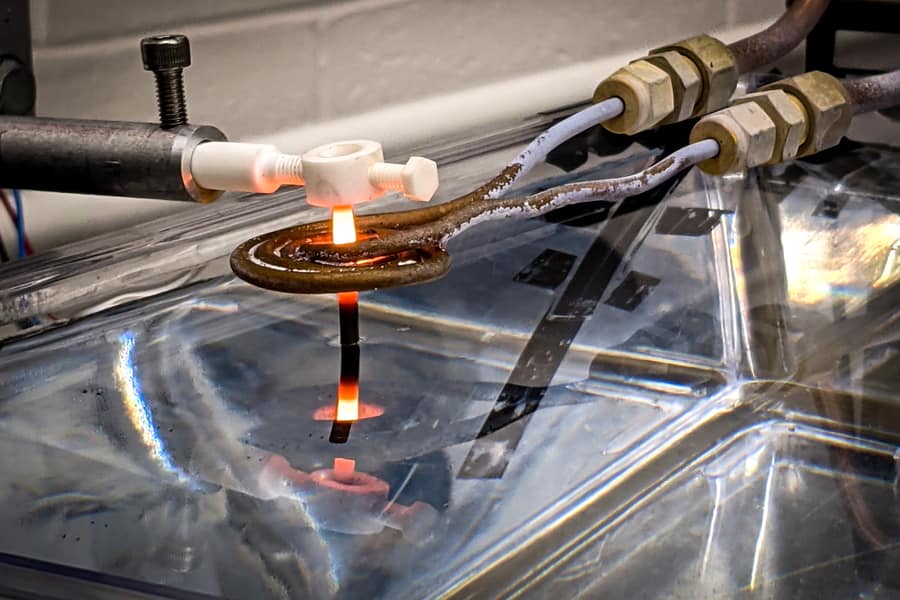
MIT researchers have developed a new heat treatment method that strengthens 3D-printed metals, enhancing their resistance to extreme thermal environments. With this breakthrough, it is now possible to 3D print high-performance blades and vanes for power-generating gas turbines and even jet engines. This innovation could be huge for the metalworks industry, which can now access the phenomenal precision of 3D printing without having to sacrifice the quality and reliability of the metal parts.
Creepy 3D printing
Gas turbine blades are typically manufactured using conventional casting processes. Manufacturers pour molten metal into complex molds and directionally solidify it. The final metal part is then refined using a variety of machining tools. These blades must be able to rotate at high speeds in extremely hot gas, to generate electricity in power plants and thrust in jet engines.
However, there is growing interest in manufacturing turbine blades through 3D printing. It offers environmental and cost benefits and allows manufacturers to produce more intricate and energy-efficient blade geometries. Unfortunately, there is one big hurdle to overcome: creep.

Creep is a metal’s tendency to permanently deform in the face of persistent mechanical stress and high temperatures. Previous research has found that the printing process produces fine grains on the order of tens to hundreds of microns in size. While almost invisible to the naked eye, this microstructure is particularly vulnerable to creep.
“In practice, this would mean a gas turbine would have a shorter life or less fuel efficiency,” explains Zachary Cordero, the Boeing Career Development Professor in Aeronautics and Astronautics at MIT.
To solve this problem, Cordero and his colleagues discovered a way to improve the structure of 3D-printed alloys by adding a new heat-treating step. This transforms the as-printed material’s fine grains into much larger “columnar” grains, a sturdier microstructure that minimizes the material’s creep. The grain “columns” are aligned with the axis of greatest stress.
The new heat treatment method could revolutionize the industrial 3D-printing of gas turbine blades, claim the authors of the new study.
“In the near future, we envision gas turbine manufacturers will print their blades and vanes at large-scale additive manufacturing plants, then post-process them using our heat treatment,” says Cordero. “3D-printing will enable new cooling architectures that can improve the thermal efficiency of a turbine, so that it produces the same amount of power while burning less fuel and ultimately emits less carbon dioxide.”
The MIT team’s new method is a form of directional recrystallization, a heat treatment that passes a material through a hot zone at a precisely controlled speed to meld a material’s many microscopic grains into larger, sturdier, and more uniform crystals.
The researchers adapted directional recrystallization for 3D-printed superalloys, which are typically cast and used in gas turbines. They tested the method on rod-shaped, 3D-printed nickel-based superalloys, which were submerged in a room-temperature water bath placed just below an induction coil. They slowly drew each rod out of the water and controlled the coil at various speeds, dramatically heating the rods to temperatures varying between 1,200 and 1,245 degrees Celsius.
They found that drawing the rods at a specific speed (2.5 millimeters per hour) and through a particular temperature (1,235 degrees Celsius) created a steep thermal gradient that triggered a transformation in the material’s printed, fine-grained microstructure.
“The material starts as small grains with defects called dislocations, that are like a mangled spaghetti,” Cordero explains. “When you heat this material up, those defects can annihilate and reconfigure, and the grains can grow. We’re continuously elongating the grains by consuming the defective material and smaller grains — a process termed recrystallization.”
The heat-treated rods were examined using optical and electron microscopy, which confirmed that the microscopic grains on the surface of the 3-D printed metal part were placed with “columnar” grains that dramatically improved creep properties. By manipulating the draw speed and temperature of the rod samples, the printing grains can reach a specific size and orientation. This level of control will likely be very welcome by turbine manufacturers.
This advancement not only marks a significant milestone in material science but also opens new avenues for innovation in various industries.
“New blade and vane geometries will enable more energy-efficient land-based gas turbines, as well as, eventually, aeroengines,” Cordero notes. “This could from a baseline perspective lead to lower carbon dioxide emissions, just through improved efficiency of these devices.”
The team’s findings were published in the journal Additive Manufacturing.









